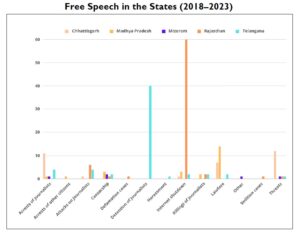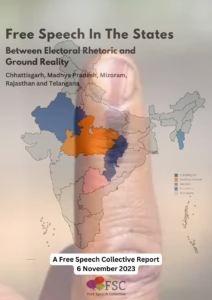Excerpted from “Let the net work: SFLC.in report on Internet Shutdowns”

Executive Summary
It is an irony that the country which prides itself on its digital initiatives like UPI cotinues to record the maxinum number of Internet Shutdowns acrosss the world. Internet shutdowns have varied impacts on different segments of the population, Much of the impact of Internet shutdowns goes undocumented. The year 2022 saw India take over the presidency of G20 and at the same time saw the highest number of shutdowns for another year in row. The
reasons for shutting down the Internet 75 times this year have ranged from prevention of cheating in exams, countering communal tensions to terrorism.

The year also saw the attempt at duplication of a colonial era legislation in the form of the Indian Telecommunication Bill 2022. The bill which does not improve the legal framework for internet shutdowns in the country. There is a
complete absence of state maintained documentation of Internet shutdowns leading to the onus falling on civil society organisations like SFLC.in to maintain the count. On a positive side, this year has also seen significant legal challenges and policy developments in the area which are expected to change the jurisprudence of Internet Shutdowns in the country. The Internet Shutdowns Tracker has been the key resource for this report, being the only real time tracker that maintains documentation around Internet Shutdowns in the country.
The report has emerged from the year around documentation that the tracker maintains. This report aims to educate its audience on the numbers around Internet Shutdowns, the impact of these shutdowns, the laws and policies governing shutdowns, the major developments around shutdowns in 2022 and to provide recommendations for
better governance in this area. This Report is a continuous part of SFLC.in’s efforts against arbitrary internet shutdowns. In addition to understanding the law which sanctions internet shutdowns and the issues which arise within it, the Report also attempts to provide information that brings forth the intensity, extent, and impact of
internet shutdowns. The report has been designed to serve as a resource for lawmakers and citizens alike, with the objective of shedding some light into the issue of internet shutdowns in India.
Impact Assessment of Internet Shutdowns
The expansion of the society and its structures into the digital realm has warranted a protection of rights in this new dimension as well. This has been judicially recognized in Faheema Shirin R.K. v The State of Kerala and Anuradha Bhasin v Union of India , by the Honourable High Court of Kerala, and the Supreme Court of India has recognised that the exercise of certain fundamental rights is contingent on access to internet. More specifically, in Faheema Shirin, in which SFLC.in was impleaded as a party, it was held that restricting access to internet violated students’ rights to access information under Article 19(1)(a) of the Constitution, and their rights to education and privacy under Article 19(1)(g).
Arbitrary and disproportionate internet shutdowns violate these, and several other rights. In this section of the Report, the impact of internet shutdowns is studied, statistically in as far as possible, to highlight the scarring effect on the economy, healthcare, and education.
Economic Impact
Internet shutdowns come at an aggressive cost to the economy and economic stability. According to Top10VP report for the year 2022, India lost $174.6 million due to internet shutdowns. Long term shutdowns have drastic impacts on the livelihood of people and directly contribute to loss of employment. The region of Kashmir, which lost access to internet for over 18 months, is the worst hit state in India, in terms of economic impact. According to a report by
Kashmir Chamber of Commerce and Industries, businesses have suffered losses worth Rupees 40,000 crore from 05 August 2019 to July 2020. Till November 2020, at least 5000 salesmen in tourism and mobile services were not paid salaries for the months of August, September and October7. Further, 4.96 lakh people lost their jobs. The President of the Kashmir Chamber of Commerce and Industries had stated that “The internet shutdown added to losses due to
disruption in online shopping and transactions after August 5 .
Online business has taken a severe blow.” It was also observed that startups, the telecommunications sector (viz-a-viz internet service providers) and courier services are among the worst hit businesses in Kashmir.
In a report prepared by SFLC.in, titled Living in Digital Darkness- A Handbook on Internet Shutdowns in India 11, it was observed that internet shutdowns not only affect big traders, E-commerce, or big companies but an Internet blackout tends to equally impact even the smallest business which has any form of Internet dependence. We
were able to speak to an operator at a service center from Mutnur village of Adilabad district who said, “Various business areas suffered when there was no internet for 30-45 days in our region. Our work includes filling of online applications, generating certificates like birth certificate, OBC certificate etc. Since we couldn’t do any bank transactions, our customers also faced a lot of inconveniences.” The impact on gig workers (food app delivery
partners, drivers who are a part of cab aggregator services), who rely on the internet entirely to perform their services for their wages, suffer severely. Shutdowns prevent them from being able to render their services entirely.
Impact on Health Care Services
The Indian Council for Research on International Economic Relations, in its report, observed that with increased digitization of health records and facilities, an internet shutdown impacts healthcare services as well. Many doctors rely on the internet for consultation with their peers, and patients also use the internet to consult doctors. These activities are normally hit due to internet shutdowns.
In SFLC.in’s report, we were able to identify database access difficulties faced by a doctor in Manipur during an internet shutdown. Apart from being able to access their server, issues were also faced in making payments, tracking shipments of medical supplies, and engage in other essential medi-care activities essential for delivering healthcare services seamlessly. Many government-provided health schemes for poor and vulnerable are affected by internet shutdowns, thereby, affecting access to healthcare. In early 2020 it was reported that many individuals who are beneficiaries of a government health scheme (Ayushman Bharat, a health insurance scheme for economically backward individuals) were not able to access healthcare as the hospitals were unable to deal with these cases due to internet blockade in Kashmir. Doctors stated that they were unable to process Ayushman Bharat cases for 25 days consecutively, after which they resorted to offline processes, which caused issues of efficiency and hampered delivery of services to beneficiaries. Access to free healthcare which was guaranteed under the scheme was obstructed due to prolonged internet shutdowns.
Impact on Education
Internet shutdowns have a severe impact on education. The importance of access to internet for the modern education sector became obvious with the online delivery of classes and administration of examinations during the COVID-19 pandemic across the world. It must be noted that over 96.33 percent of internet users in India are mobile internet users and over 75 percent internet shutdowns affect mobile internet services. This worsens the digital
divide that already exists in the country. With respect to long term internet shutdowns, it was observed that
some students dropped out of schools or missed an entire year of schooling. In Kashmir it was reported that, due to low internet speed and connectivity issues the syllabus for the academic year had to be reduced by 40 percent.
Parents of children reported that students have been discouraged to attend the classes due to low speed. It also
caused emotional and mental health issues to many students who were not able to access education. In some cases, students were unable to appear in important government held examinations for entrance into colleges for higher education and for government jobs. Or in some cases people travelled to different cities in order to appear in exams or even to obtain study material.
A petition was filed in the Supreme Court of India [Foundation for Media Professionals v. UT of J&K and anr.]23 stating the challenges students and schools were facing at the start of the pandemic. It was contended in this petition that an internet shutdown during a pandemic, particularly, is a violation of right to education of all the children living in Kashmir.
The Court’s dismissal of the petition was premised on the argument that stat security would supersede education, especially where terrorism is concerned. This was a decision arrived at after consideration offered by the Court to the desirability and convenience of access to internet in light of “a worldwide pandemic and a national lockdown”.
There are recorded incidents of students having had to appear for exams physically despite the pandemic. Students of Kurukshetra University, a renowned educational institution in the State of Haryana, had exams scheduled as a routine part of their curriculum during the pandemic. This schedule coincided with the “farmers protests’” in the State, in reaction to which shutdown orders were put in place from September 7-9, 2021. Subsequently, a statement was
released by the Controller of Examinations of the University that students would either have to arrange broadband within a day, or write exams physically. SFLC.in wrote to the University administration, highlighting the arbitrariness of the instructions in the statement, and implored the postponement of the examinations, or extension of an alternative to the students. This case study is crucial in understanding the tangible impact, in this instance of health
and safety of students, which were a direct fallout of a reactive internet shutdown.
Read/download the report here:


